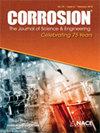Localized Corrosion of High-Grade Stainless Steels in Chlorinated Seawater
IF 1.1
4区 材料科学
Q4 MATERIALS SCIENCE, MULTIDISCIPLINARY
引用次数: 0
Abstract
Chlorination is widely used in seawater systems to avoid fouling. Free chlorine is a strong oxidizing agent that prevents the biofilm formation on immersed surfaces, when used above a certain content. However, the presence of residual chlorine associated with the high chloride content in seawater, significantly increases the risk of localized corrosion for most stainless steels. In the present study, a module initially developed to quantify the formation of electroactive biofilms on stainless steels has been used to assess the corrosivity of chlorinated seawater. Both the electrochemical potential and the cathodic current were measured on super-duplex stainless steel as a function of residual chlorine levels and seawater temperatures. In parallel, long term localized corrosion tests have been performed in simulated environments to assess the environmental limits for safe use of high-grade stainless steels in chlorinated seawater. It includes crevice corrosion exposure tests using adapted ISO18070:2015 crevice formers and internal tube pitting corrosion exposure tests in model tube heat exchangers simulating heat flux from 35°C to 170°C. The synergetic effect of residual chlorine content and temperature on the risk of localized corrosion has been quantified. Corrosion resistance properties are correlated to the electrochemical monitoring data, and the environmental limits of selected stainless steels have been established for duplex stainless steel UNS S32205, super-duplex stainless steel UNS S32750, hyper-duplex stainless steel UNS S32707 and the high-grade austenitic stainless steel UNS S31266.高档不锈钢在氯化海水中的局部腐蚀
氯化被广泛用于海水系统以避免污染。游离氯是一种强氧化剂,当使用超过一定含量时,可防止浸入表面形成生物膜。然而,海水中氯含量高导致残留氯的存在,大大增加了大多数不锈钢局部腐蚀的风险。在本研究中,一个最初用于量化不锈钢上电活性生物膜形成的模块已用于评估氯化海水的腐蚀性。在超级双相不锈钢上测量了电化学电势和阴极电流,作为余氯水平和海水温度的函数。同时,在模拟环境中进行了长期局部腐蚀试验,以评估在氯化海水中安全使用高级不锈钢的环境限制。它包括使用适用的ISO18070:2015缝隙形成器进行的缝隙腐蚀暴露测试,以及模拟35°C至170°C热通量的模型管式换热器中的内管点蚀暴露测试。余氯含量和温度对局部腐蚀风险的协同作用已被量化。耐腐蚀性能与电化学监测数据相关,并确定了双相不锈钢UNS S32205、超双相不锈钢UNS S32750、超双相和不锈钢UNS S32707和高级奥氏体不锈钢UNS S3 1266所选不锈钢的环境极限。
本文章由计算机程序翻译,如有差异,请以英文原文为准。
求助全文
约1分钟内获得全文
求助全文
来源期刊

Corrosion
MATERIALS SCIENCE, MULTIDISCIPLINARY-METALLURGY & METALLURGICAL ENGINEERING
CiteScore
2.80
自引率
12.50%
发文量
97
审稿时长
3 months
期刊介绍:
CORROSION is the premier research journal featuring peer-reviewed technical articles from the world’s top researchers and provides a permanent record of progress in the science and technology of corrosion prevention and control. The scope of the journal includes the latest developments in areas of corrosion metallurgy, mechanisms, predictors, cracking (sulfide stress, stress corrosion, hydrogen-induced), passivation, and CO2 corrosion.
70+ years and over 7,100 peer-reviewed articles with advances in corrosion science and engineering have been published in CORROSION. The journal publishes seven article types – original articles, invited critical reviews, technical notes, corrosion communications fast-tracked for rapid publication, special research topic issues, research letters of yearly annual conference student poster sessions, and scientific investigations of field corrosion processes. CORROSION, the Journal of Science and Engineering, serves as an important communication platform for academics, researchers, technical libraries, and universities.
Articles considered for CORROSION should have significant permanent value and should accomplish at least one of the following objectives:
• Contribute awareness of corrosion phenomena,
• Advance understanding of fundamental process, and/or
• Further the knowledge of techniques and practices used to reduce corrosion.
 求助内容:
求助内容: 应助结果提醒方式:
应助结果提醒方式:


